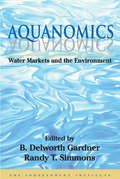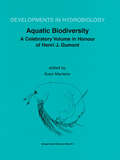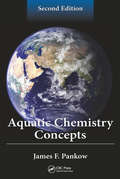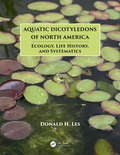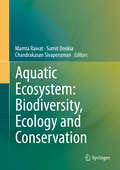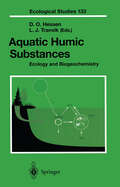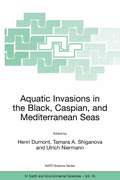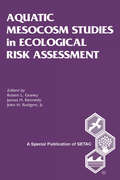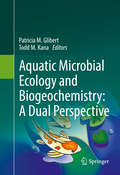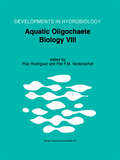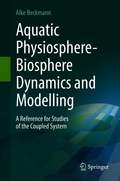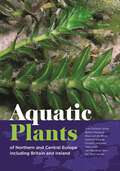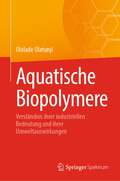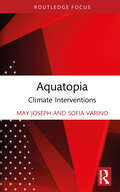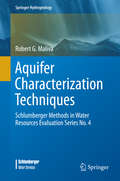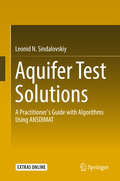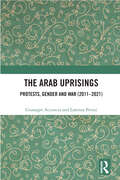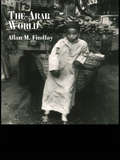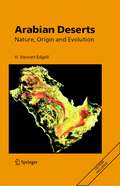- Table View
- List View
Aquanomics: Water Markets and the Environment
by Randy SimmonsWater is becoming increasingly scarce. If recent usage trends continue, shortages are inevitable. Aquanomics discusses some of the instruments and policies that may be implemented to postpone, or even avoid, the onset of water crises. These policies include establishing secure and transferable private water rights and extending these rights to uses that traditionally have not been allowed, including altering in-stream flows and ecosystem functions. The editors argue that such policies will help maximize water quantity and quality as water becomes scarcer and more valuable. Aquanomics contains many examples of how this is being accomplished, particularly in the formation of water markets and market-like exchanges of water rights.Many observers see calamity ahead unless water supplies are harnessed and effectively conserved, and unless water quality can be improved. It is also clear that declining water quality is a serious problem in much of the world, as increasing human activities induce high levels of water degradation. Those who voice these concerns, argue the contributors to this volume, fail to consider the forces for improvement inherent in market political-economic systems that can address water issues. The contributors see water quality in economically advanced countries as improving, and they believe this establishes the validity of market-based approaches.
Aquatic Biodiversity: A Celebratory Volume in Honour of Henri J. Dumont (Developments in Hydrobiology #171)
by Koen MartensIn this age of increased fundamental and applied research on biodiversity, no single volume was as yet devoted to the various temporal and spatial aspects of aquatic biodiversity. The present book is published in honour of Professor Henri Dumont (Ghent, Belgium) at the occasion of his retirement as Editor-in-Chief of Hydrobiologia. The volume presents a selection of contributions on aquatic biodiversity, written by colleagues from the editorial board, fellow editors of aquatic journals and former students and collaborators. Contributions deal with a wide spectrum of topics related to aquatic biodiversity and cover fields such as actual- and palaeolimnology, taxonomy, and fundamental and applied limnology. Even reconnaissance chapters on management and cultural impact of water bodies are included. The book combines state-of-the-art contributions in aquatic sciences.
Aquatic Chemistry Concepts, Second Edition
by James F. PankowAquatic Chemistry Concepts, Second Edition, is a fully revised and updated textbook that fills the need for a comprehensive treatment of aquatic chemistry and covers the many complicated equations and principles of aquatic chemistry. It presents the established science of equilibrium water chemistry using the uniquely recognizable, step-by-step Pankow format, which allows a broad and deep understanding of aquatic chemistry. The text is appropriate for a wide audience, including undergraduate and graduate students, industry professionals, consultants, and regulators. Every professional using water chemistry will want this text within close reach, and students and professionals alike will expect to find at least one copy on their library shelves. Key Features Extremely thorough, one-of-a-kind treatment of aquatic chemistry Discussions of how to carry out complex calculations regarding the chemistry of lakes, rivers, groundwater, and seawater Numerous example problems worked in complete detail Special foreword by Jerry L. Schnoor
Aquatic Chemistry Concepts, Second Edition
by James F. PankowAquatic Chemistry Concepts, Second Edition, is a fully revised and updated textbook that fills the need for a comprehensive treatment of aquatic chemistry and covers the many complicated equations and principles of aquatic chemistry. It presents the established science of equilibrium water chemistry using the uniquely recognizable, step-by-step Pankow format, which allows a broad and deep understanding of aquatic chemistry. The text is appropriate for a wide audience, including undergraduate and graduate students, industry professionals, consultants, and regulators. Every professional using water chemistry will want this text within close reach, and students and professionals alike will expect to find at least one copy on their library shelves. Key Features Extremely thorough, one-of-a-kind treatment of aquatic chemistry Discussions of how to carry out complex calculations regarding the chemistry of lakes, rivers, groundwater, and seawater Numerous example problems worked in complete detail Special foreword by Jerry L. Schnoor
Aquatic Dicotyledons of North America: Ecology, Life History, and Systematics
by Donald H. LesAquatic Dicotyledons of North America: Ecology, Life History, and Systematics brings together a wealth of information on the natural history, ecology, and systematics of North American aquatic plants. Most books on aquatic plants have a taxonomic focus and are intended primarily for identification. Instead, this book provides a comprehensive overview of the biology of major aquatic species by compiling information from numerous sources that lie scattered among the primary literature, herbarium databases, and other reference materials. Included dicotyledon species are those having an obligate (OBL) wetland status, a designation used in the USACE National Wetland Plant List. Recent phylogenetic analyses are incorporated and rationale is provided for interpreting this information with respect to species relationships. This diverse assemblage of information will be useful to a wide range of interests including academic researchers, wildlife managers, students, and virtually anyone interested in the natural history of aquatic and wetland plants. Although focusing specifically on North America, the cosmopolitan distribution of many aquatic plants should make this an attractive text to people working virtually anywhere outside of the region as well. This book is an essential resource for assisting with wetland delineation.
Aquatic Dicotyledons of North America: Ecology, Life History, and Systematics
by Donald H. LesAquatic Dicotyledons of North America: Ecology, Life History, and Systematics brings together a wealth of information on the natural history, ecology, and systematics of North American aquatic plants. Most books on aquatic plants have a taxonomic focus and are intended primarily for identification. Instead, this book provides a comprehensive overview of the biology of major aquatic species by compiling information from numerous sources that lie scattered among the primary literature, herbarium databases, and other reference materials. Included dicotyledon species are those having an obligate (OBL) wetland status, a designation used in the USACE National Wetland Plant List. Recent phylogenetic analyses are incorporated and rationale is provided for interpreting this information with respect to species relationships. This diverse assemblage of information will be useful to a wide range of interests including academic researchers, wildlife managers, students, and virtually anyone interested in the natural history of aquatic and wetland plants. Although focusing specifically on North America, the cosmopolitan distribution of many aquatic plants should make this an attractive text to people working virtually anywhere outside of the region as well. This book is an essential resource for assisting with wetland delineation.
Aquatic Ecosystem: Biodiversity, Ecology And Conservation
by Mamta Rawat Sumit Dookia Chandrakasan SivaperumanThis book brings together the latest information on the rapid advances and developments in the field of aquatic ecology. India is very rich in terms of biological diversity due to its wide range of habitats and climatic conditions. It is home to as much as 7 per cent of the world’s animal species, although it only accounts for about 2 per cent of the total landmass. The present work on biodiversity, ecology and conservation of aquatic resources represents original research in the field of aquatic biodiversity, wetland ecology and its applications with reference to the country’s aquatic resources. There are 19 chapters, each contributed by an expert in his/her particular field and offering novel approaches to various topics in the area of aquatic ecosystems.
Aquatic Humic Substances: Ecology and Biogeochemistry (Ecological Studies #133)
by Dag Hessen Lars J. TranvikHumic substances occur in all kinds of aquatic systems, but are particularly important in northern, coniferous areas. They strongly modify the aquatic ecosystems and also constitute a major problem in the drinking water supply.This volume covers all aspects of aquatic humic substances, from their origin and chemical properties, their effects on light and nutrient regimes and biogeochemical cycling, to their role regarding organisms, productivity and food web organization from bacteria to fish. Special emphasis is paid to carbon cycling and food web organization in humic lakes, but aspects of marine carbon cycling related to humus are treated as well.
Aquatic Invasions in the Black, Caspian, and Mediterranean Seas (Nato Science Series: IV: #35)
by Henri Dumont Tamara A. Shiganova Ulrich NiermannThe Mediterranean, Black, and Caspian Seas, the rivers and canals that connect them, and the enormous volume of shipping in the region, represent a conduit for aquatic invasion, whose consequences are only now beginning to be understood. This book provides an up-to-date overview of jelly invasions in the Ponto-Caspian which have affected local ecosystems since the early 1980s, contrasting that with other biological invasions, in search of underlying principles.
Aquatic Mesocosm Studies in Ecological Risk Assessment
by Robert L. GraneyA Special Publication of the Society of Environmental Toxicology and Chemistry (SETAC)Aquatic Mesocosm Studies in Ecological Risk Assessment discusses the methods currently used for conducting simulated field studies and provides a series of case histories in which mesocosm type studies have been used to assess the impact of pesticides on aquatic ecosystems. Specific chapters address the dosing and exposure components of such studies and how they influence experimental design. Advantages and disadvantages of various statistical designs are addressed in detail. Regulatory aspects of the design and interpretation of these studies are also covered. The book will be a superb reference for aquatic biologists, ecologists, toxicologists, environmental toxicologists, environmental chemists, and regulatory personnel.
Aquatic Mesocosm Studies in Ecological Risk Assessment
by Robert L. GraneyA Special Publication of the Society of Environmental Toxicology and Chemistry (SETAC)Aquatic Mesocosm Studies in Ecological Risk Assessment discusses the methods currently used for conducting simulated field studies and provides a series of case histories in which mesocosm type studies have been used to assess the impact of pesticides on aquatic ecosystems. Specific chapters address the dosing and exposure components of such studies and how they influence experimental design. Advantages and disadvantages of various statistical designs are addressed in detail. Regulatory aspects of the design and interpretation of these studies are also covered. The book will be a superb reference for aquatic biologists, ecologists, toxicologists, environmental toxicologists, environmental chemists, and regulatory personnel.
Aquatic Microbial Ecology and Biogeochemistry: A Dual Perspective
by Patricia M. Glibert Todd M. KanaThis book highlights perspectives, insights, and data in the coupled fields of aquatic microbial ecology and biogeochemistry when viewed through the lens of collaborative duos – dual career couples. Their synergy and collaborative interactions have contributed substantially to our contemporary understanding of pattern, process and dynamics. This is thus a book by dual career couples about dual scientific processes.The papers herein represent wide-ranging topics, from the processes that structure microbial diversity to nitrogen and photosynthesis metabolism, to dynamics of changing ecosystems and processes and dynamics in individual ecosystems. In all, these papers take us from the Arctic to Africa, from the Arabian Sea to Australia, from small lakes in Maine and Yellowstone hot vents to the Sargasso Sea, and in the process provide analyses that make us think about the structure and function of all of these systems in the aquatic realm. This book is useful not only for the depth and breadth of knowledge conveyed in its chapters, but serves to guide dual career couples faced with the great challenges only they face. Great teams do make great science.
Aquatic Oligochaete Biology VIII: Proceedings of the 8th International Symposium on Aquati Oligochaeta, held in Bilbao, Spain, 18–22 July 2000 (Developments in Hydrobiology #158)
by Pilar Rodriguez Piet F. M. VerdonschotThis book contains 26 contributions dealing with the biology of aquatic oligochaetes and covers a wide range of topics including taxonomy, morphology, ultrastructure, embryology, reproduction, feeding biology, ecotoxicity, community studies, and species distribution. Descriptions of new taxa in tropical areas, including Amazonian forest soils, as well as overviews on the biodiversity of aquatic oligochaetes in Australia and European groundwaters, are presented. New morphological characteristics in both marine and freshwater species are described and interpreted. Laboratory studies contribute to the knowledge of oligochaete feeding biology and reproduction. The use of aquatic oligochaetes in ecological risk assessment is analysed in detail, and standardised experimental designs for studies on bioaccumulation and pollutant transfer by food are included. Finally, a number of papers present the effects of oliogochaetes on the performance of an activated sludge plant, and multivariate approaches to the spatial and/or temporal distribution and composition of oligochaete communities in many different areas of the world, from the scale of a river to the scale of the microhabitat. The broad scope of this volume is a reflection of recent rends, not only in oligochaete research, but also in general applied biological studies.
Aquatic Physiosphere-Biosphere Dynamics and Modelling: A Reference for Studies of the Coupled System
by Aike BeckmannThis encyclopedia is a reference for aquatic physical, biological and biogeochemical sciences, collecting and connecting a number of topics, concepts and facts about aquatic systems and their scientific investigation. The scope of the book comprises the aquatic physiosphere-biosphere transition zone, an entity that encompasses both inanimate matter and collectives (the physiosphere) as well as living organisms and collectives (the biosphere). This combined approach is meaningful because both realms are intimately linked and because available methods of investigation are often similar. Much can be gained from considering both spheres at and across their interface jointly, and while there is a strong focus on marine systems, most concepts presented are also applicable to freshwater systems. This presented snapshot of knowledge of the transition zone between the aquatic physiosphere and biosphere is taken from a very specific angle: the point of view of a modeler. Modeling is not only a state-of-the-art mode of scientific investigation, but also requires the explicit specification of all assumptions (helping to avoid fallacies), and offers the advantage of being quantitative and allows for theoretical "what if" scenarios.As in any reference work, equal emphasis is given to fundamental facts, the definition of terms and the explanation of concepts, in an attempt to establish a joint language for physicists, biologists and biogeochemists. Although originating from a modeler's approach to nature, the resulting suite of compatible concepts may also be useful beyond modeling purposes. Furthermore, the material is presented in a condensed, straightforward way. Hence, the length of each entry is limited to one (occasionally two) pages, thus offering a quick introductory overview. This excludes lengthy derivations and very specialized details. The book is geared towards researchers, teachers and advanced students in the field of aquatic (marine and limnic) sciences, in particular those interested or involved in interdisciplinary work.
Aquatic Plants of Northern and Central Europe including Britain and Ireland (WILDGuides #118)
by Jens Christian Schou Bjarne Moeslund Dr. Klaus van Weyer Gerhard Wiegleb Richard V. Lansdown Peter Holm Lars Baastrup-Spohr Kaj Sand-JensenThe first comprehensive guide to the aquatic plants of the regionBeneath the surface of bodies of freshwater—springs, streams, rivers, ponds and lakes—there is a world of plants of great variety and beauty, a realm that is often poorly known and understood. Correctly identified, these plants can tell us much about the character and condition of the habitats in which they live. A collaboration of Danish, German, and British field botanists specializing in freshwater plants, this guide presents all of the known aquatic plants of Northern and Central Europe, including Britain and Ireland, as well as many marginal and wetland species.This is the first comprehensive guide to the identification of the region&’s 410 species and hybrids of both native and non-native ferns and flowering plants that are dependent upon freshwater wetlands. Following the latest taxonomy, the book features 358 plates in pen and ink, more than 1,400 colour photographs, illustrated keys, distribution maps and detailed descriptions. The introduction gives an overview of evolution, anatomy and morphology, ecology, eco-physiology, research traditions and more, and the book also includes guidelines for working with aquatic plants.The first comprehensive guide to the region&’s aquatic plantsCovers all 410 known speciesFeatures 358 illustrated plates, more than 1,400 colour photographs, distribution maps, detailed descriptions and much more
Aquatische Biopolymere: Verständnis ihrer industriellen Bedeutung und ihrer Umweltauswirkungen
by Ololade OlatunjiDieses Buch gibt einen umfassenden Überblick über die jüngsten Entwicklungen bei industriellen Anwendungen, Verarbeitungstechniken und Modifikationen von Polymeren aus marinen Quellen. Es führt den Leser systematisch in die Biomaterialien Chitin, Kollagen, Alginate, Cellulose und Polyester ein und stellt eine Verbindung zwischen ihrer industriellen Bedeutung und ihren Auswirkungen auf die Umwelt her. Das Buch verdeutlicht die Auswirkungen der industriellen Nutzung des aquatischen Systems für organische und anorganische Stoffe auf die Umwelt und vertieft das Verständnis der industriellen und wirtschaftlichen Bedeutung aquatischer Biopolymere. Darüber hinaus geht es um die Frage, wie die Erhaltung des aquatischen Lebens und das industrielle und wirtschaftliche Interesse an der Entwicklung biologisch abbaubarer Alternativen für Kunststoffe in Einklang gebracht werden können. Das Buch richtet sich daher an Wissenschaftler:innen aus den Bereichen Chemie, Material- und Polymerwissenschaften sowie Ingenieurwesen.
Aquatopia: Climate Interventions (Critical Climate Studies)
by May Joseph Sofia VarinoAquatopia documents Harmattan Theater’s ecological interventions and traces its engagements with water-bound landscapes, colonial histories, climate change, and public space across New York City, Venice, Amsterdam, Lisbon, and Cochin. The volume uses Harmattan’s site-specific performances as a point of departure to consider climate change and rising sea levels as geographical, ecological, and urban phenomena. Instead of a collection of flat, static surfaces, the Aquatopia atlas is animated by a disorienting, anti-mapping strategy, producing a deterritorialized, nomadic, fluid atlas unfolding in real time as an archive of climate change in multidimensional, active space. The book is designed for pedagogical access, with interludes that consolidate the learning outcomes of the experimental theory animating each site-specific performance. Accompanied by close descriptions of five performances and supplemented by digital documentation available online, this volume intervenes in discussions on climate change, urbanism, and postcolonization/decolonialization, and contributes to interdisciplinary studies of ecology and environmental politics, postcolonial/decolonial theories and practices, performance studies and aesthetics, in particular public art, and performance as research.
Aquatopia: Climate Interventions (Critical Climate Studies)
by May Joseph Sofia VarinoAquatopia documents Harmattan Theater’s ecological interventions and traces its engagements with water-bound landscapes, colonial histories, climate change, and public space across New York City, Venice, Amsterdam, Lisbon, and Cochin. The volume uses Harmattan’s site-specific performances as a point of departure to consider climate change and rising sea levels as geographical, ecological, and urban phenomena. Instead of a collection of flat, static surfaces, the Aquatopia atlas is animated by a disorienting, anti-mapping strategy, producing a deterritorialized, nomadic, fluid atlas unfolding in real time as an archive of climate change in multidimensional, active space. The book is designed for pedagogical access, with interludes that consolidate the learning outcomes of the experimental theory animating each site-specific performance. Accompanied by close descriptions of five performances and supplemented by digital documentation available online, this volume intervenes in discussions on climate change, urbanism, and postcolonization/decolonialization, and contributes to interdisciplinary studies of ecology and environmental politics, postcolonial/decolonial theories and practices, performance studies and aesthetics, in particular public art, and performance as research.
Aquifer Characterization Techniques: Schlumberger Methods in Water Resources Evaluation Series No. 4 (Springer Hydrogeology)
by Robert G. MalivaThis book presents an overview of techniques that are available to characterize sedimentary aquifers. Groundwater flow and solute transport are strongly affected by aquifer heterogeneity. Improved aquifer characterization can allow for a better conceptual understanding of aquifer systems, which can lead to more accurate groundwater models and successful water management solutions, such as contaminant remediation and managed aquifer recharge systems. This book has an applied perspective in that it considers the practicality of techniques for actual groundwater management and development projects in terms of costs, technical resources and expertise required, and investigation time. A discussion of the geological causes, types, and scales of aquifer heterogeneity is first provided. Aquifer characterization methods are then discussed, followed by chapters on data upscaling, groundwater modelling, and geostatistics. This book is a must for every practitioner, graduate student, or researcher dealing with aquifer characterization .
Aquifer Test Solutions: A Practitioner’s Guide with Algorithms Using ANSDIMAT
by Leonid N. SindalovskiyThis book, designed as a handbook, provides a systematic treatment of analytical solutions describing groundwater flow during aquifer tests. The book integrates the majority of known solutions from well hydraulics and subsurface flow theory, starting with pioneering work from the early 20th century up to the most recent publications in scientific journals. The book includes about 300 transient solutions covering a wide range of aquifer test scenarios and hydrogeological conditions. All the solutions have been thoroughly tested and implemented in the multifunctional ANSDIMAT software. The book comprises three parts and is supplemented by appendices.The first part of the book is dedicated to basic analytical relationships referring to pumping tests with constant discharge rate. Conceptual models describe confined, unconfined, confined–unconfined, inhomogeneous, and fracture-porous aquifers, as well as leaky aquifers and multi-layer aquifer systems. Complicating factors such as flow boundaries, aquifer anisotropy, non-uniform aquifer thickness, partial well penetration, wellbore storage and skin, the effect of capillary forces are also considered.The second part focuses on complex pumping test settings and well system configurations. Analytical solutions are presented for pumping from a horizontal or inclined well, constant-head tests, multi-well variable-discharge tests, simultaneous pumping from adjacent aquifers and dipole flow tests. Detailed descriptions are given for slug and recovery tests.The third part of the book contains algorithms for evaluating hydraulic characteristics using analytical and graphical methods, and is supplemented by the ANSDIMAT tool. This software includes solutions for some practical engineering-hydrogeological problems, in particular, the assessment of aquifer characteristics by data on groundwater level monitoring and the evaluation of water inflow into open pits.The book is supplemented with appendices in which hydrogeologists can find a vast body of useful information including mathematical descriptions of the majority of analytical functions used in the book, their plots and possible approximations.Audience:The book is useful for hydrogeologists (students, engineers and researchers) engaged in groundwater flow studies, aquifer test analysis, environmental geologists and civil engineers. Experts in water flow numerical modeling and programmers developing software for aquifer tests will find valuable information in this book, which can also be used for educational and research purposes.
The Arab Uprisings: Protests, Gender and War (2011-2021)
by Giuseppe Acconcia Lorenza PeriniThis book investigates the role of social groups in mobilizing resources for protests in repressive contexts. In particular, it examines the impact of organizations and informal groups on individual engagement in the protests developed in 2010–2011 in Tunisia, Egypt, and Syria. Empirical analysis draws on a wave of events and protests that took place between 2010 and 2021. It explores how, in repressive contexts, spontaneous groups and more established and formal organizations continuously switch from one form to another, transforming themselves faster than they would do in democratic contexts.
The Arab Uprisings: Protests, Gender and War (2011-2021)
by Giuseppe Acconcia Lorenza PeriniThis book investigates the role of social groups in mobilizing resources for protests in repressive contexts. In particular, it examines the impact of organizations and informal groups on individual engagement in the protests developed in 2010–2011 in Tunisia, Egypt, and Syria. Empirical analysis draws on a wave of events and protests that took place between 2010 and 2021. It explores how, in repressive contexts, spontaneous groups and more established and formal organizations continuously switch from one form to another, transforming themselves faster than they would do in democratic contexts.
The Arab World (Routledge Introductions to Development)
by Allan M. FindlayDisruption following the Gulf War, and the need to satisfy both rising economic aspirations and the Islamic values of the region's peoples, demands fresh examination of development issues in the Arab world. This introductory text assesses how agricultural, industrial and urban development has evolved in the Arab region. Contrasting Arab and Western interpretations of `development', it draws on case studies covering states as diverse as Saudi Arabia, Yemen, Morocco and Jordan. The author suggests that until the Arabs define their own identity, there will continue to be `change' but not necessarily `progress' in the region.
The Arab World (Routledge Introductions to Development)
by Allan M. FindlayDisruption following the Gulf War, and the need to satisfy both rising economic aspirations and the Islamic values of the region's peoples, demands fresh examination of development issues in the Arab world. This introductory text assesses how agricultural, industrial and urban development has evolved in the Arab region. Contrasting Arab and Western interpretations of `development', it draws on case studies covering states as diverse as Saudi Arabia, Yemen, Morocco and Jordan. The author suggests that until the Arabs define their own identity, there will continue to be `change' but not necessarily `progress' in the region.
Arabian Deserts: Nature, Origin and Evolution
by H. Stewart EdgellThis is the first comprehensive survey of all the deserts of Arabia, based largely on the author’s 50 years of experience there. The text deals with every kind of desert in the region, from vast sand seas to clay pans and stony plains to volcanic flows. Along with dune types unique to the region the author outlines climatic changes, current ecology and human influence on desertification.
